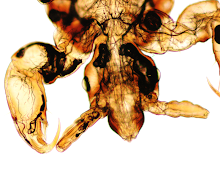

A parasitologist's view of the world
"Pathresident" got this one correct. Nice job!
This is the scolex (head) of the pork tape worm, T. solium, distinguished by its size (approximately 1 mm wide), 4 suckers, and armed rostellum (hooklets on the rounded projection from its scolex). The closely related beef tapeworm, T. saginata, has 4 suckers but no hooklets on its rostellum. The scolex is occasionally identified in feces, and when present, allows for definitive speciation of the Taenia tapeworms, which otherwise look very similar in gross appearance. Identifying the number of uterine branches in the proglottids is the only other way to tell the 2 species apart. The eggs of both are identical and only identify the presence of a Taenia species.
Other cestodes may also have a similar appearing scolex: Hymenolepis nana and H. diminuta also have 4 suckers and an armed rostellum, but are much smaller in width (and length) than T. solium, and the scolex is more knob-like. The scolex of Dipylidium caninum is also similar, but is also much smaller and has a retractable armed rostellum, so the hooklets may appear to be internalized. Finally, the scolex of Echinococcus spp. is also armed with 4 suckers, but the adult tapeworm is only found in dogs and other canids, and NOT humans. Therefore, as mentioned by the first commenter, this would only be found in dog feces, not human.
Answer: Tungiasis
Congratulations to the readers who wrote in with the correct answer! You all realized that the large size of a foreign appearing organism embedded in skin, combined with the suggestive history, is consistent with Tungiasis. Another commenter gets special bonus points for the entertaining answer “gel foam with eggs”. I think that most pathologists would think the same thing when faced with this interesting and complex appearing arthropod on H&E.
Thankfully, the diagnosis can easily be made with a rudimentary knowledge of this organism, (that is, without entomology training). The presence of the complex internal structures indicates that this is an arthropod and not a foreign body such as a splinter. The large size rules out the diagnosis of scabies. Helpful features include the thick brown exoskeleton and eggs in cross-section (see image). Other diagnoses to consider include cutaneous myiasis (infection with fly larvae), tick mouth parts, and cutaneous larva migrans.
(CLICK ON IMAGE TO ENLARGE)
Tungiasis, also known as ‘jiggers’, is a condition caused by infestation with the fertilized female flea Tunga penetrans (a.k.a. ‘jigger flea’ or ‘chigoe’). This is the only flea to burrow into human skin; she buries in head first and feeds on blood from the dermal capillaries. Her posterior end remains exposed so that she may release her eggs. Eventually, she may reach the size of a pea. The presence of the foreign object in the epidermis and dermis results in abscess formation, and frequently, secondary bacterial infection.
Tungiasis is prevalent in Sub-Sarahan Africa, Central and South America, and the Carribean - including some popular vacation destinations! Exposure to the sand flea occurs while walking barefoot on the beach, so protective footwear is required for prevention. Infestation typically occurs on the feet around the nails, but other sites include the thighs, buttocks, abdomen and hands. Treatment is sterile removal of the lesion.
Thanks for reading. Answers and new cases are posted every Monday!
This was a difficult case since the objects in the movie were not very clear. However, the clues to the diagnosis were the patients history (itchy rash shared with his dog) and the short stumpy legs seen intermittently on the video, characteristic of the “itch mite”, Sarcoptes scabiei.
Notice the short stumpy legs (arrows) and rounded body:
One commenter suggested that this was the human body louse; however, this arthropod would also not expect to infect other mammals such as the dog, and has a much more elongated body shape. Thanks to everyone who wrote in on this case!
